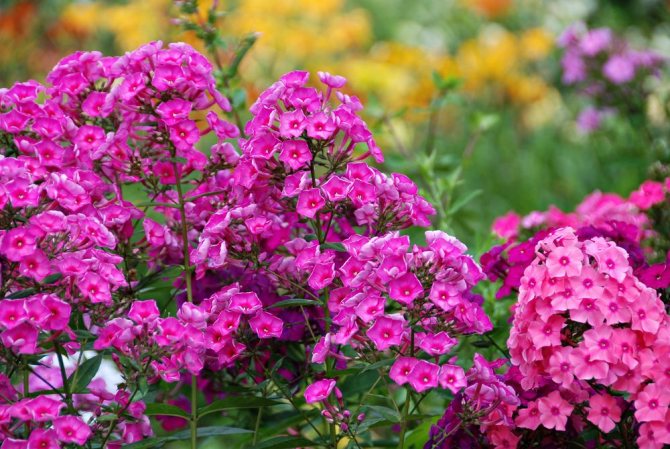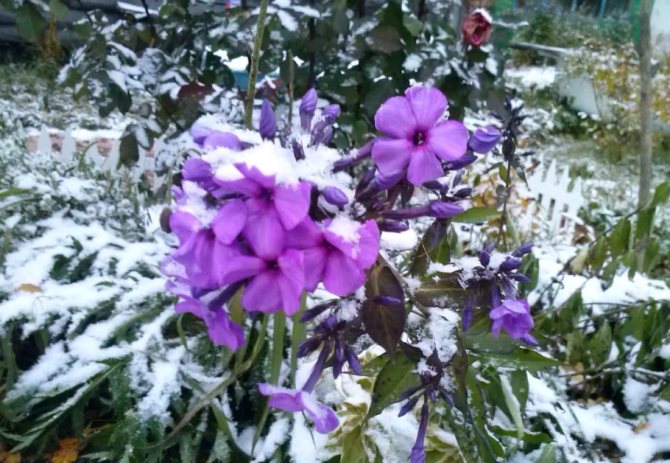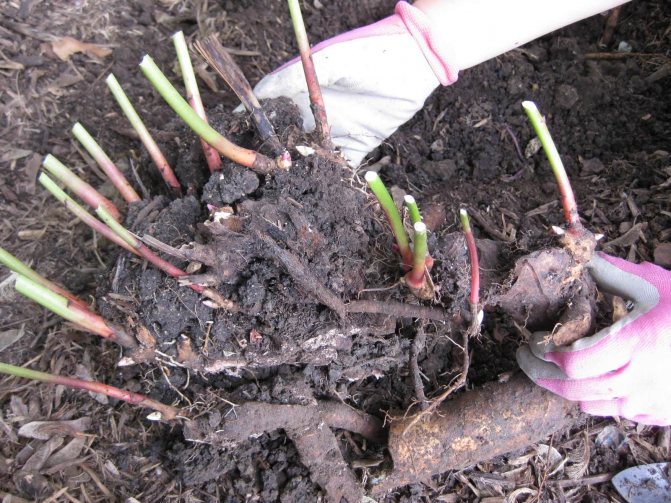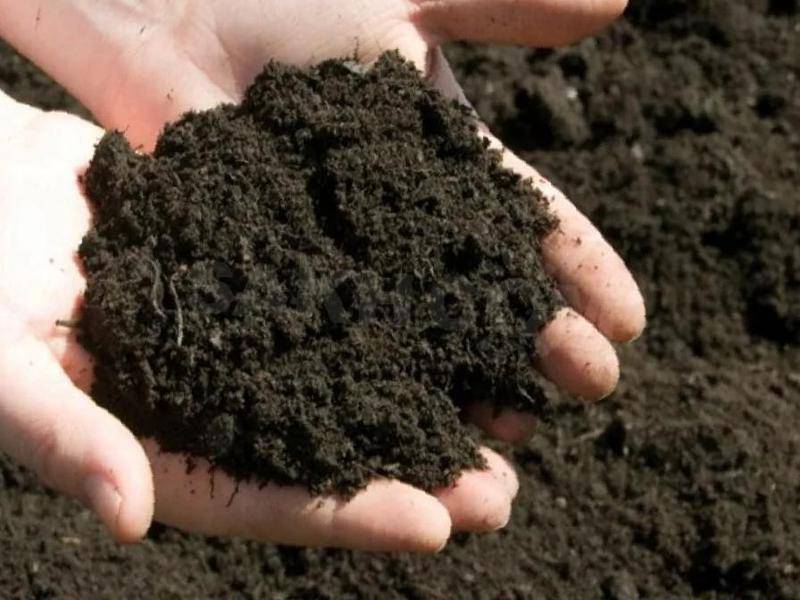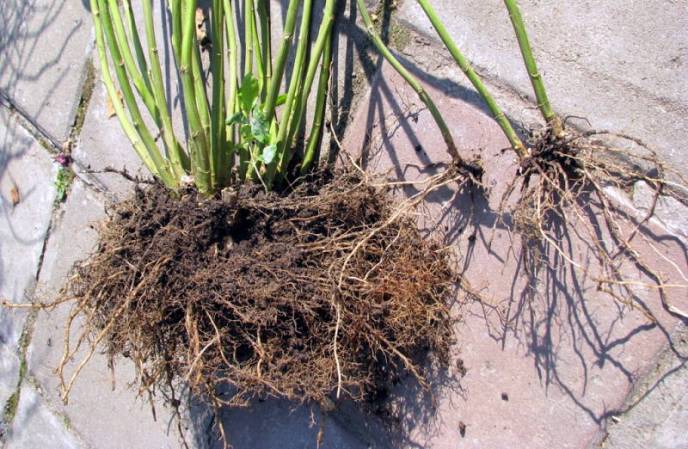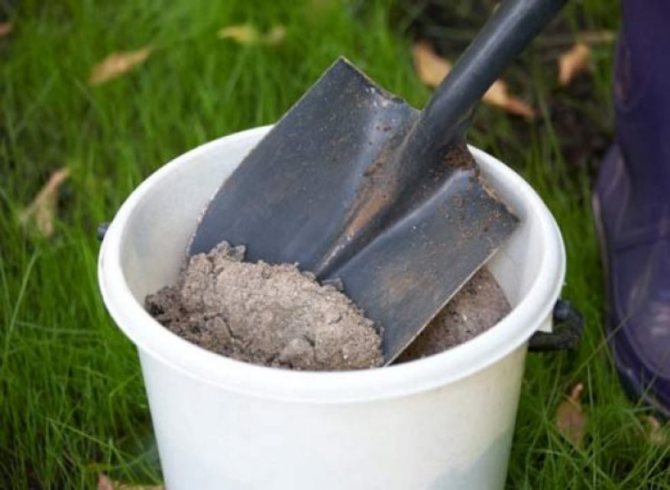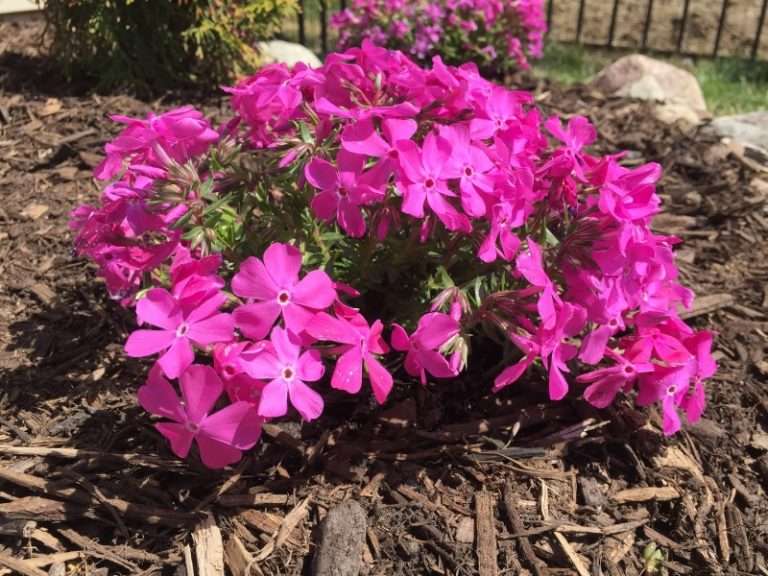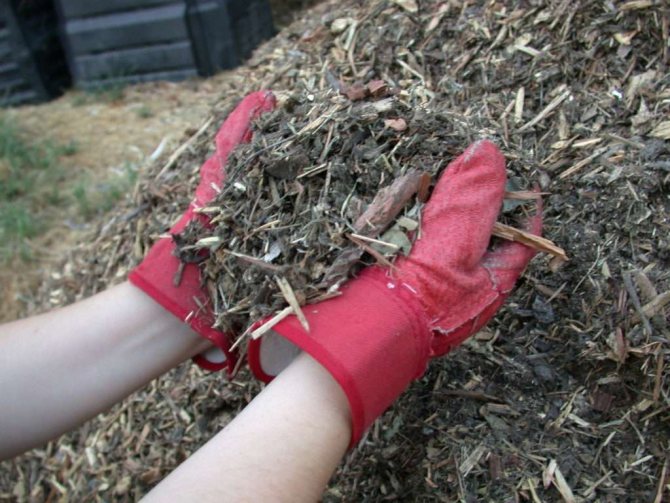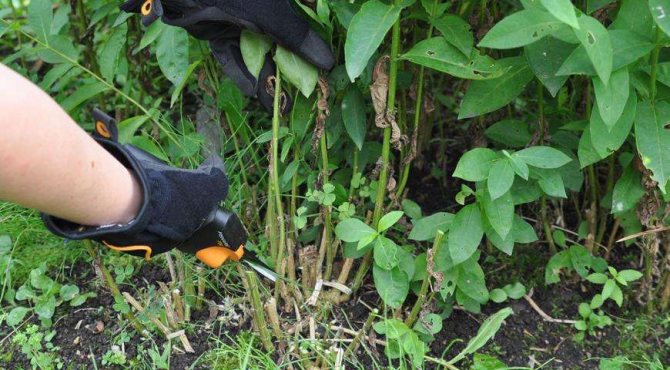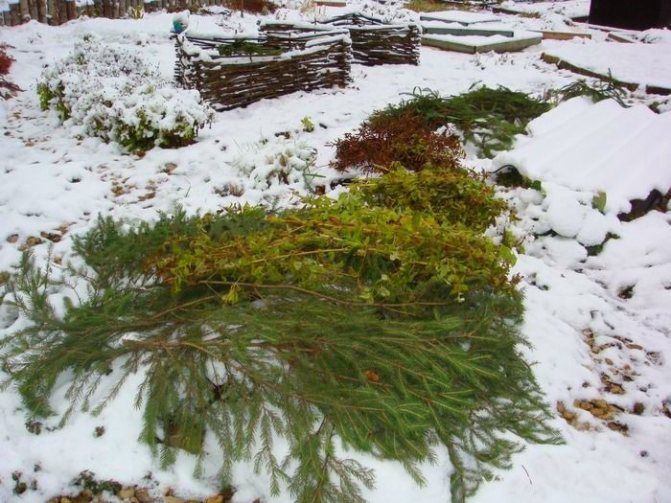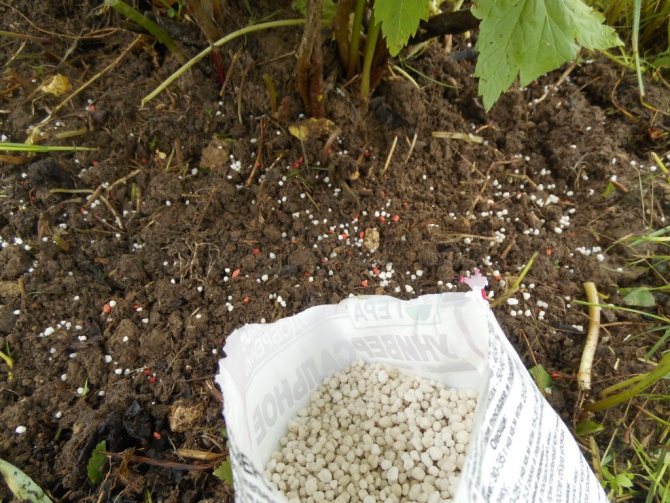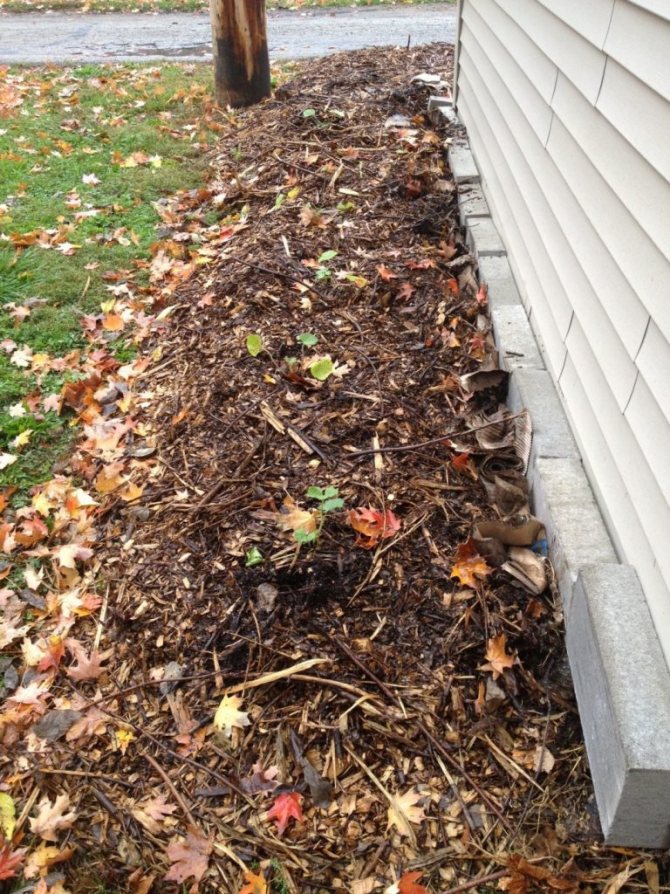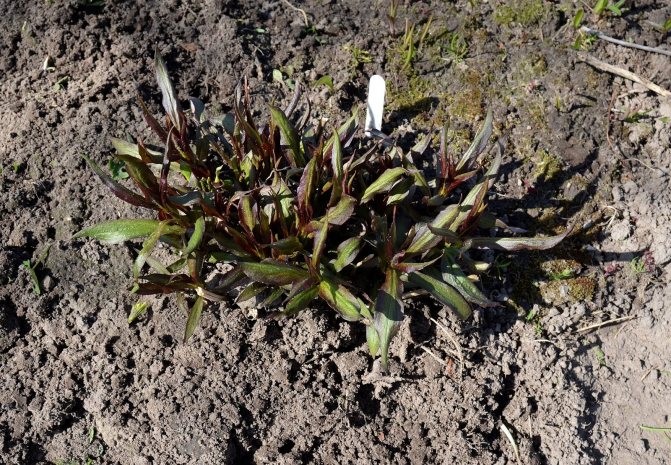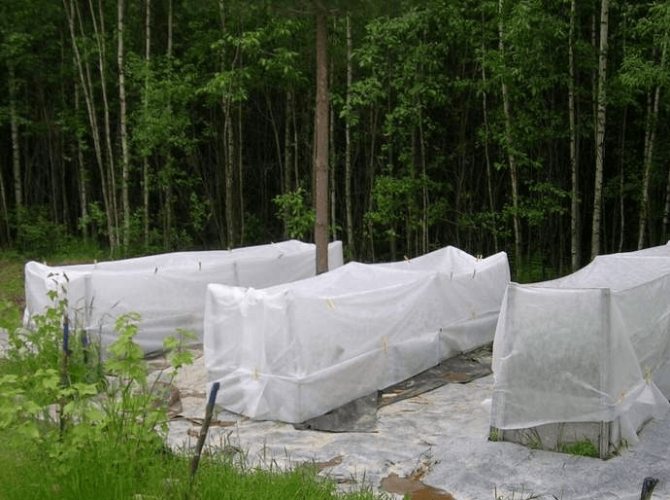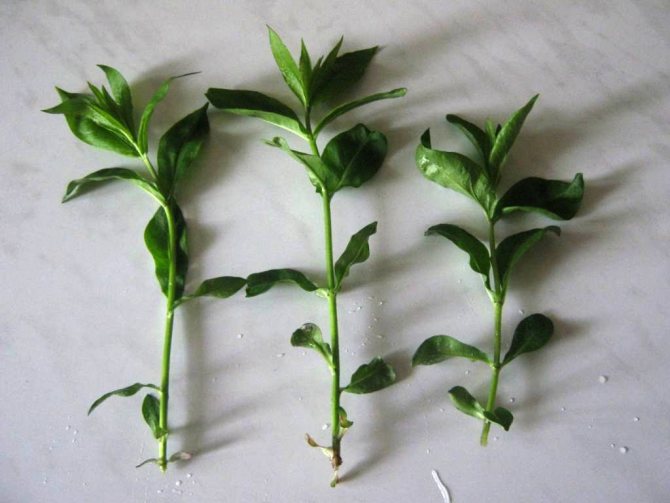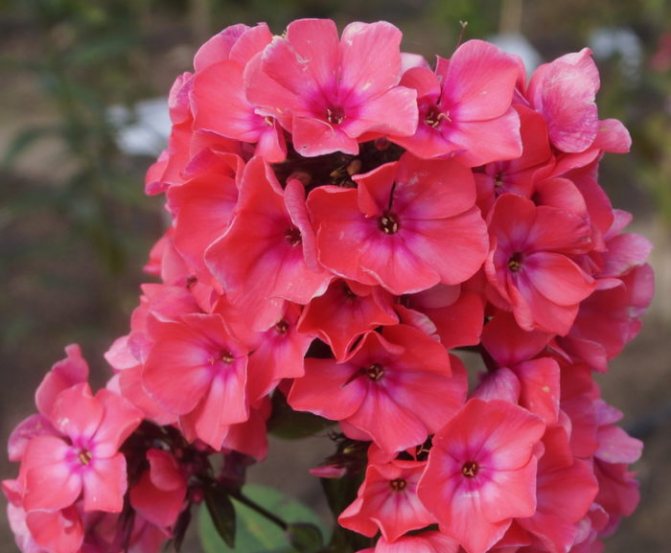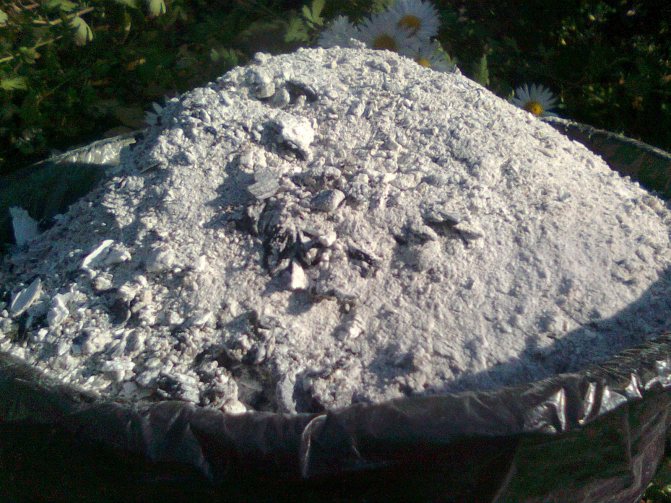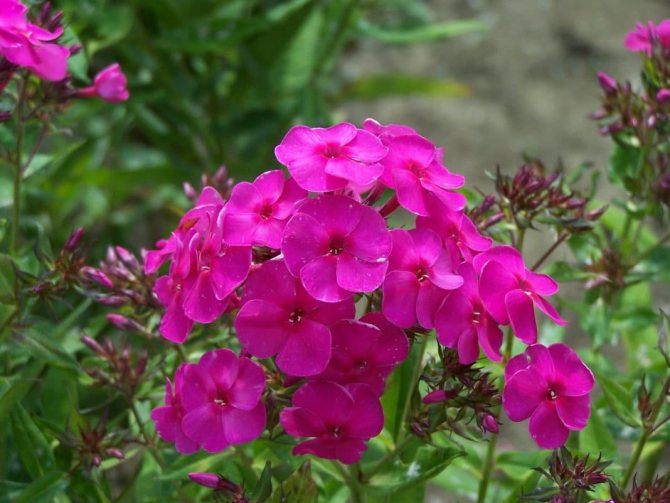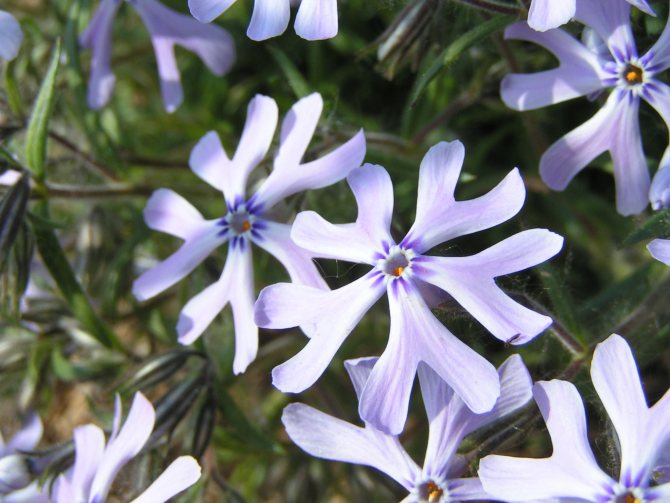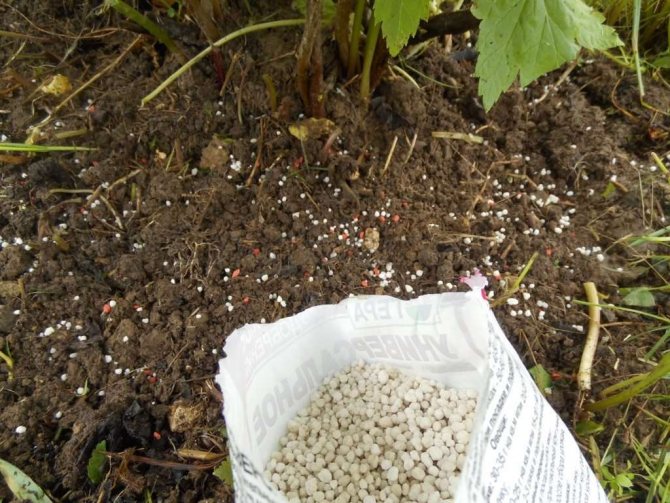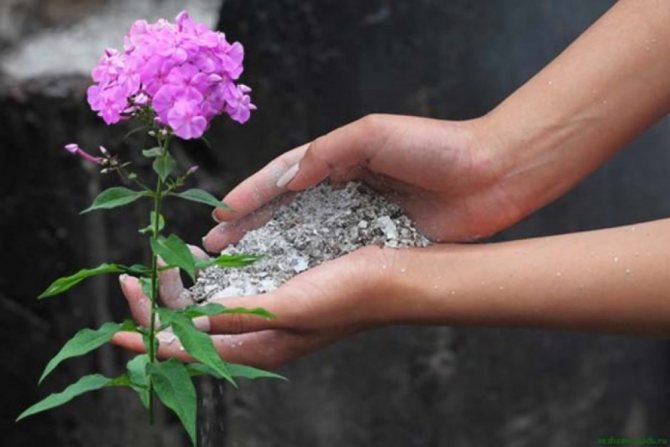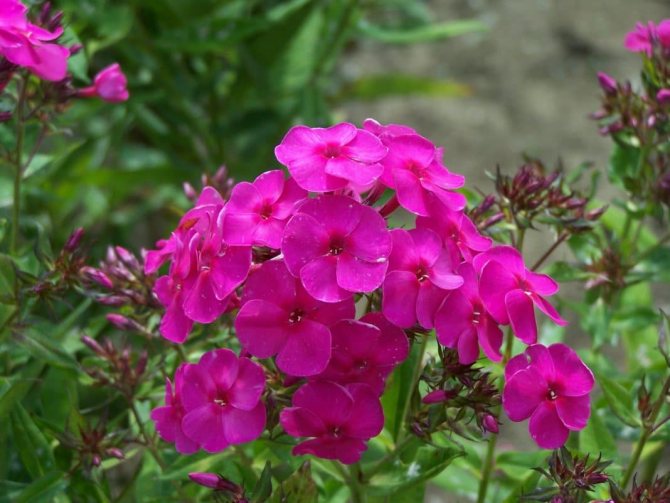It is possible to decorate flower beds, paths and recreation areas not only with the help of decorative details. Various types of plants do an excellent job with the task. Bright elegant phloxes create a positive atmosphere of comfort and joy. Adequate care and proper preparation of phlox for winter will help prolong the life of a flower.
- 1 Pruning work
- 2 Video "Preparing phlox for winter" 2.1 Top dressing after the procedure
Pruning work
Autumn care for phlox consists of the usual agrotechnical measures: water-charging irrigation, fungicide treatment, pruning, fertilizing, soil mulching and shelter. Not all gardeners and summer residents believe that phloxes need to be cut in the fall. However, the procedure not only stimulates the growth and development of new shoots in the spring. Sanitary pruning protects against pests and fungal infections, whose spores and larvae can hide in wilted foliage and dead plant parts. Also, cut bushes are easier to handle (spray and mulch).

Timely pruning enables the roots to accumulate the full amount of nutrients necessary for wintering. Nutrition of the root system is the key to a successful wintering of the flower. The pruning time depends on two factors - the type of phlox and the climatic characteristics of the region. The early bushes are pruned at the end of September, the late ones from the middle of October. Pruning begins only after the plant has completely bloomed, and nutrients from the green parts begin to flow to the root system. Finish the procedure before the onset of permanent frost.
Phlox are cut in three ways:
- All shoots are cut off, leaving stumps several centimeters high. Almost complete removal of the aerial part reduces the risk of developing fungal diseases to a minimum. Pests accumulated in it are also removed along with the vegetation.
- The aerial part is cut in such a way that stumps of 7–10 cm remain. These stumps become the basis for the development of young spring shoots. However, according to experience, they are weaker and bloom worse than those that grow directly from the roots.
- After pruning, the aerial portion remains more than 10 cm. Most gardeners will prune the plant this way. Although the remaining part is problematic to process, and the risk of pests and fungal spores overwintering in it is quite high. This pruning scheme is good in regions where there is a lot of snow in the winter.
Timing is an important point in the procedure. If you prune phloxes too early, they will sprout new shoots before the cold weather sets in. Late pruning will prevent the root system from accumulating enough nutrients for the dormant period.
Autumn pruning phlox
Pruning in summer after flowering
Even in the summer, some time after flowering, so that the plant does not spend extra energy on ripening the seeds, you need to remove the faded peduncles at a distance of 50-60 cm from the ground, leaving most of the green mass.
Interesting! It is believed that if you break off the top of a dry flower, then later it will bloom with lateral flowers, i.e. phloxes will be able to bloom 2 times (albeit not as luxuriantly as the first time).On the other hand, pruning the tops, which stimulates the growth of side shoots and subsequent flowering, will also take a lot of energy from the plant, which would be better spent on preparing for wintering. Therefore, it is advisable to hold this event only if you have a long enough summer.
Why prune phlox for the winter
Autumn pruning of phlox, like many other perennials, is carried out in order to get rid of all kinds of problems that may appear in the future, namely, to prevent fungal diseases and protect against insect pests (i.e., so that various pathogens and pest larvae).
Advice! Accordingly, all the trimmed above-ground part must be removed from the site or burned, and not thrown onto the compost heap.
On the other hand, if your phloxes have never been sick, there are no signs of disease and pest, then why not use their aboveground part as a natural mulch to cover the bushes themselves, or still send it to the compost heap.
Video: pruning phlox
When to prune phloxes in the fall: optimal timing
According to most gardeners, phlox pruning for the winter should be carried out in late autumn, preferably before the onset of stable frosts, i.e. not earlier than the end of September-beginning of October (for the Middle Lane) - beginning of November (relevant for warmer regions).
Important! Naturally, phlox pruning for the winter is carried out after the bush has completely faded, turns yellow and dries up, i.e. nutrients from the aboveground part will completely transfer to the underground (to the roots).
Video: when and how to cut phlox for the winter
How to properly prune phlox for the winter
It's simple: phloxes are cut in the fall right at ground level, trying not to leave any stumps (similar to the same herbaceous peonies).
Interesting! There is a rather controversial opinion that 5-10 centimeter stumps should be left in order for snow to better hold and linger over the bushes in winter. However, in practice, no special effect is observed from this, but next spring the sticking out "sticks" will only interfere with you (after all, they will have to be removed in any case) when new shoots begin to appear from the ground.
Leaving after pruning - autumn feeding and weeding
Further, after pruning (although it is possible before it, i.e. after summer pruning after flowering), it is highly recommended to feed phlox with autumn fertilizer, in other words, add some phosphorus and potash fertilizers under the bush. For example, it can be superphosphate (1 tablespoon under a medium bush) and potassium sulfate (1 tablespoon) or wood ash (2 tablespoons).
And just before the phlox shelter for the winter, you should get rid of the weeds.
Video "Preparing phlox for winter"
In this video, you will learn how to properly prepare phlox for the winter period.
Top dressing after the procedure
After pruning, the flower needs to be watered and processed. It is recommended to burn all trimmed parts away from any cultivated plants. You can destroy fungal spores using fungicide treatment. Before feeding, the near-stem zone must be loosened and watered abundantly. Further, mineral fertilizers are applied under the bush. Usually superphosphate is mixed with ash in small quantities.
When to trim and cover phloxes - timing
The timing and methods of preparing plants for winter depend on the climate of the area and the specific place of growth. So, if phlox grows under a tree, then it needs less shelter, since a snowdrift usually forms near the trunk.
The general rules for trimming and covering are as follows:
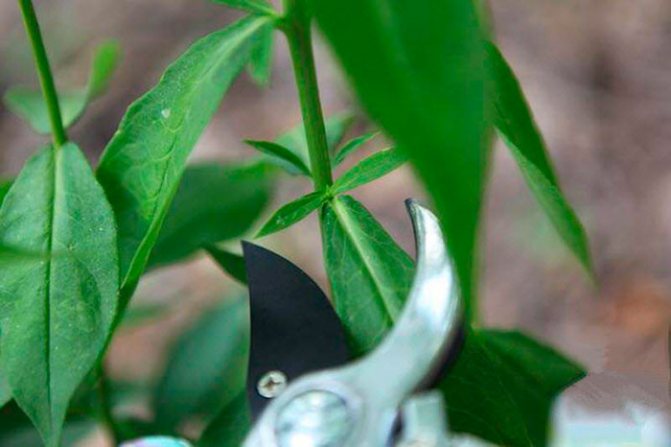

Pruning
- Pruning is done when the plant has bloomed. But you do not need to prune the stems while the bush is still green.As foliage and stems continue to accumulate nutrients and nourish the roots. This will help them cope better with the cold.
- No need to rush to cover. After the first frost, there may still be warming. In this case, there is a risk that the roots will begin to rot and rot. The shelter is made after light freezing of the soil.
- For the same reason, you should not use dense material such as roofing material, linoleum, etc. as a covering material. The shelter should be "breathing", so it is better to use spruce branches, peat. All types of manure and manure, including horse, cow, chicken, give a warming effect.
Preparation of phlox for winter in the Moscow region begins after about October 10. Frost-resistant varieties are usually not covered here. Imported breeding varieties, as well as plants with a still unrooted system, for example, after an autumn planting, must be covered.
In the regions of the Urals and Siberia, pruning can be carried out from the beginning of October. Here phloxes save the snowy winters. A large amount of snow protects the roots from frost. But, since it is impossible to predict weather surprises, most often even frost-resistant phlox varieties are sheltered in these areas. And some types of phlox are even dug up and stored in a cool place.
Shelter before the onset of cold weather
Preparing a flower for winter does not end with the care measures listed above. Whether it is necessary to cover phloxes for the winter depends on the growing region and crop variety. Depending on the growing area of the phlox, it may need different types of shelter. Subulate phlox, which are usually grown in our country, tolerate mild continental winters well. However, frosts below 15 ° C can kill the plant. The danger for the plant is not only severe frosts, but also long thaws: the flower can have time to start up young shoots, which will be further frostbitten. Also, the scorching rays of the sun can burn the remaining stems. Therefore, it is recommended to cover not only frost-resistant varieties, but also others.
Before sheltering, phloxes must be prepared: mulch with peat, compost or humus. To insulate the plant, you need a layer of about 10 cm. Then the bush can be covered with spruce branches, which retains snow, but lets air through. It is impossible to cover phloxes with special airtight materials (film, linoleum) - the lack of ventilation and a lack of moisture contribute to the development of the decay process. The shelter is removed immediately after the end of the period of frost and strong night frosts.
How to properly prune phlox after flowering - a practical guide for beginners
Phloxes impress with their variety of colors. Due to their amazing shades, flowers are often used in the preparation of exclusive landscape designs. Plants do not require special care and thrive in all regions of the country. But a florist should know that pruning phlox after flowering is necessary not only for full growth and formation of buds, but also for the healthy development of bushes.


The nuances of the procedure in different areas
The way phlox shelters for the winter and its need directly depend on the place where the flower is grown. Winter in the middle lane, in particular in the Moscow region, is not too harsh. Therefore, rotted manure is used as insulation for the bush. In the regions of the Volga region, hemp is not cut at the very root, but left about 8 cm, mulched and covered with branches or tops. The same shelter scheme is also suitable for the Urals; a layer of snow is laid on top of such a shelter. Siberia, with its harsh winters and bitter frosts, will need a better shelter. The plant is not cut off or left about 20 cm, completely covered with mulch and covered with spruce branches or corn (or sunflower) tops. It is also practiced to dig up a flower and place it in a container, which is transferred to a cool room.
Landing in open ground
The root system of the plant is superficial, so when planting phloxes do not deeply deepen. When digging the soil, the rhizomes of the weeds are carefully removed so that they do not interfere with the growth of sods. Until the phlox planting has turned into a solid carpet, regular weeding is a mandatory procedure in the first 1-2 years.
Phlox seedlings are planted in prepared pits or holes to a depth of 10-15 cm at a distance of 25-30 cm from each other. After planting, they are watered abundantly.
The article "Perennial phloxes - species and popular varieties" will help you to choose the seeds of subulate phlox, which describes the varieties of all known perennial phloxes.
Watering
Phlox subulate drought-resistant. This is one of the benefits of the plant. It is regularly watered (2-3 times a week) only in severe drought. The rest of the time there is enough natural precipitation.
Top dressing
During the season, the plant is fed 2-3 times. The application of nitrogen-potash fertilizers in spring will give an impetus for active growth, top dressing with complex mineral fertilizers in the middle of summer will contribute to lush flowering. A good effect is given by root and foliar ash dressings. Ash contains micro and macro elements necessary for phlox. At the same time, there is no nitrogen in it, the increased doses of which negatively affect flowering. In addition, ash solutions protect phlox from pests. It is better to combine top dressing with watering, so as not to burn the leaves.
You can feed subulate phlox according to a different scheme. In the spring, after the snow melts and the earth dries up, the soil around the phlox is loosened and mulched with humus mixed with wood ash. In the summer they do without top dressing, and in the fall the bushes are mulched again with humus.
Phlox subulate frost-resistant and does not need shelter in the Middle Lane. But since the plant has a superficial root system, in the spring, after the snow melts, the roots are bare. A layer of compost or humus 1-2 cm thick, poured in the fall, will protect them, and phloxes will successfully overwinter.
Phlox subulate well tolerates a haircut. In early spring, it is recommended to cut only yellowed or dried stems at the ends. After the end of flowering, the overgrown shoots and parts of the stems with wilted flowers are cut off. Pruning a bush by 30-50% is a powerful anti-aging procedure. It returns the former beauty to the plant.
Fatal mistakes of inexperienced florists


Simple summer residents and novice florists can make a number of typical mistakes in caring for phlox:
- application of nitrogen-containing fertilizers before wintering: such feeding stimulates the growth of new shoots, as a result of the growth of which the root system does not receive the necessary nutrients;
- too hasty warming of the plant: do not cover the flower before the onset of regular frosts;
- the use of materials for shelter that do not allow air and moisture to pass through;
- incorrect cropping.
Features of plant care after wintering
Upon awakening in spring, the perennial gradually gains green mass and takes on attractive forms. To speed up the growing season and restore the activity of the root system, plantings are fed with complex fertilizers with a predominance of nitrogenous compounds.
After wintering, it is important to inspect the bush, remove damaged shoots, broken branches. If it is necessary to stimulate growth, phlox is treated with special biological products. For example, you can use "Epin" or "Zircon", which help to awaken dormant growth buds and cause a rapid set of vegetative mass.
First aid for freezing
If the bush is slightly frozen, then you should not despair right away. You can try to revive it. It is necessary to cut out the middle of the bush with a sharp sterile knife, leaving only 3-4 cm edges.Then the resulting void is covered with nutritious soil and treated with a growth stimulant.
After treatment, the growth of dormant buds is stimulated, which will release new shoots.
It is not difficult to take care of phlox, the main thing is to do everything in a timely manner, using simple tips.
Is it possible to plant phlox in the fall
Autumn planting of phlox is good in its own way:
- In the spring, planting should be carried out within 14 days, and in the fall, for this, gardeners have as much as 40 days.
- If phlox planting is carried out correctly in the fall, you can see the full flowering of the plant next summer. When planted in spring, the buds form later and may not bloom.
Dates of planting phlox in the fall
If you plant phlox of early varieties, it is necessary to plant at the end of August. Phlox varieties with late flowering are left until the end of September. Before the frost begins, the plants must take root.
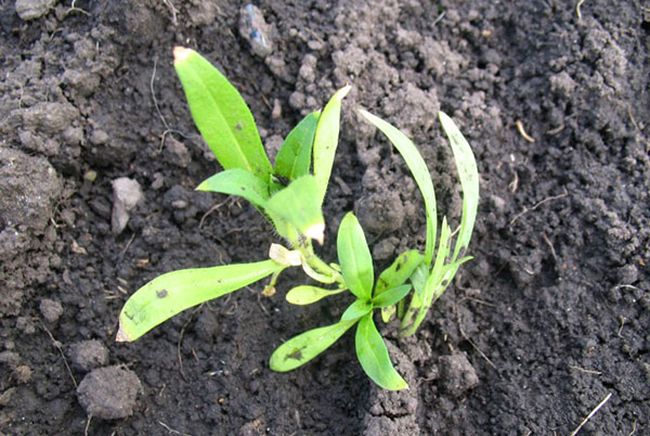

Choosing planting material
Important! It is recommended to choose large cuttings. They hibernate more easily as they root better.
For planting, a split with two thick stems is suitable. They are cut off and the large buds that are at the base are cut off. The roots are shortened to 15 centimeters.
In the autumn, those plants that were planted in the spring are transplanted. When transplanting, you need to cut off only the top, leaving only a couple of healthy leaves.
You may be interested in: Planting beet seeds in open ground
How to choose a landing site
The landing site is prepared in two weeks so that the earth has time to sink. The site is cleared of weeds. The soil should be medium clay. It is better if the acidity is neutral.
When digging, mineral fertilizers are applied. It is imperative to dig deep into the soil, since the phlox root system is very powerful. The phlox well is made deep and wide enough.
The well is watered well, filled with humus, ash, phosphorus fertilizers and put there a delen. It is sprinkled with earth. Some gardeners use a root growth stimulant by soaking the cuttings in it.
You can plant phlox in clean sand. A deep hole is dug, at the bottom of which, instead of earth, clay is poured with a layer of 20 cm. The soil mixture is poured on top. After planting, the soil is tamped.
Terms of work
From the first decade of September to the second decade of October - pruning phlox. The timing of phlox pruning is influenced by the variety. Early flowering varieties bloom by the end of August, their pruning begins in the first or second decade of September.
Late-flowering varieties bloom by the end of September, pruned in the first or second decade of October.
In the third decade of September - the first decade of October, the remaining stumps and the soil around phloxes are treated with Fitosporin-M or Fundazol.
At the same time, a complex of mineral fertilizers is applied.
Phlox mulch no earlier than October 15. You can postpone this event to a later time, when the ground is already frozen.
Top dressing rules
The effectiveness and benefit of the procedure depends on adherence to the rules. In order not to harm the plant, it is important to follow the instructions carefully. Correct feeding consists in using the required dose of the drug, in favorable weather conditions and the correct method of application.
Fertilizer use rules:
- It is inappropriate to fertilize in dry and windy weather. It is better to apply liquid organic matter in spring, in loosened, abundantly moist soil. It is allowed to feed flowers by foliar method in the morning or after sunset, on a calm, cloudy, but not rainy day.
- It is very important to strictly observe the dosage and prepare solutions according to the instructions. Excessive concentration of the substance can lead to burns and even death of the plant.
- The best result can be achieved if phlox is fed with fertilizer in a dissolved form.For this, the required amount of the component is diluted in a large volume of water and the bushes are watered with the composition.
- The use of dry mixtures is allowed when feeding phlox before winter, with abundant watering or rainy weather, for digging. Local application usually requires embedding the substance into wet soil to a depth of 20 cm.
- The foliar method provides additional nutrition. It is produced in late spring and summer by spraying beneficial solutions on the stems and leaves of flowers. Used for prophylaxis and in the case when the plant urgently needs to be fed (in case of illness).
If you feed phloxes not according to the rules, you can burn the root system, disrupt the balance of nutrients and soil microflora. And this will significantly impair the quality of phlox flowering and can lead to their death.
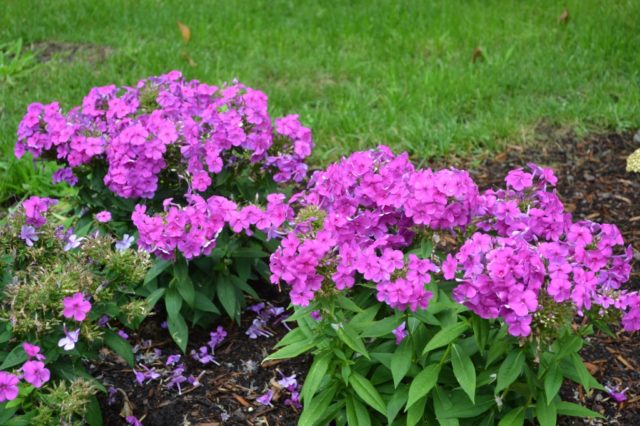

Top dressing never hurts if done correctly
Tips for florists
Summing up, you can give the following recommendations that will be useful to growers who grow phlox in their areas:
- In the fall, you can additionally carry out top dressing with the help of liquid fecal masses, but such fertilizers are not recommended for plants that have been transplanted to a new location.
- Meadow geranium, daylilies and iris can become not only good neighbors for phlox, but their joint landing on the same site is also allowed.
- For preventive treatment in the fall, it is best to use the preparations "Fundazol" or "Fitosporin-M". They may not always be found on the market, but these options are the most effective.
What elements are needed and what fertilizers do phloxes like?
Phlox are herbaceous plants that include both annuals and perennials. They are appreciated for their wonderful scent, long-lasting vitality and ease of care. A feature of the culture is the variety of flowering. Inflorescences are presented in almost all shades of the natural palette.
For full flowering, phloxes need the following elements:
- Phosphorus involved in the processes of photosynthesis.
- Potassium, which regulates water balance.
- Calcium, which provides root development and plant nutrition.
- Nitrogen compounds affecting the growth and development of culture.
- Iron, which takes part in the formation of chlorophyll.
- Copper, which activates nitrogen-carbohydrate metabolism.


Today there are more than 1,500 types of phlox in the world.
With regard to the flowering of phlox, the factor of the timeliness of feeding is very important. So, in early spring, complex mineral preparations are used for fertilization. At the end of the spring season, organic matter is relevant to stimulate flowering: mullein, wood ash, compost and humus. In the summer, urea is applied, foliar fertilizers are also actively used.
In August, they are fed with phosphorus-type mixtures (superphosphate). Preparation for winter includes feeding with wood ash and superphosphate. This guarantees an increase in the immunity and frost resistance of plants, as well as their abundant flowering in the next season.
Signs that you need feeding phlox in the fall
There are a number of signs indicating the need for feeding perennial phloxes in the fall. These include:
- delayed flowering;
- dull shade of leaves;
- pale color of phlox flowers;
- yellowing and falling off of leaf plates.
In most cases, these signs indicate a deficiency of elements such as phosphorus, magnesium, potassium and copper.
Important! The sooner signs of micronutrient deficiencies are noticed and appropriate measures are taken, the sooner phloxes will regain their strength.

